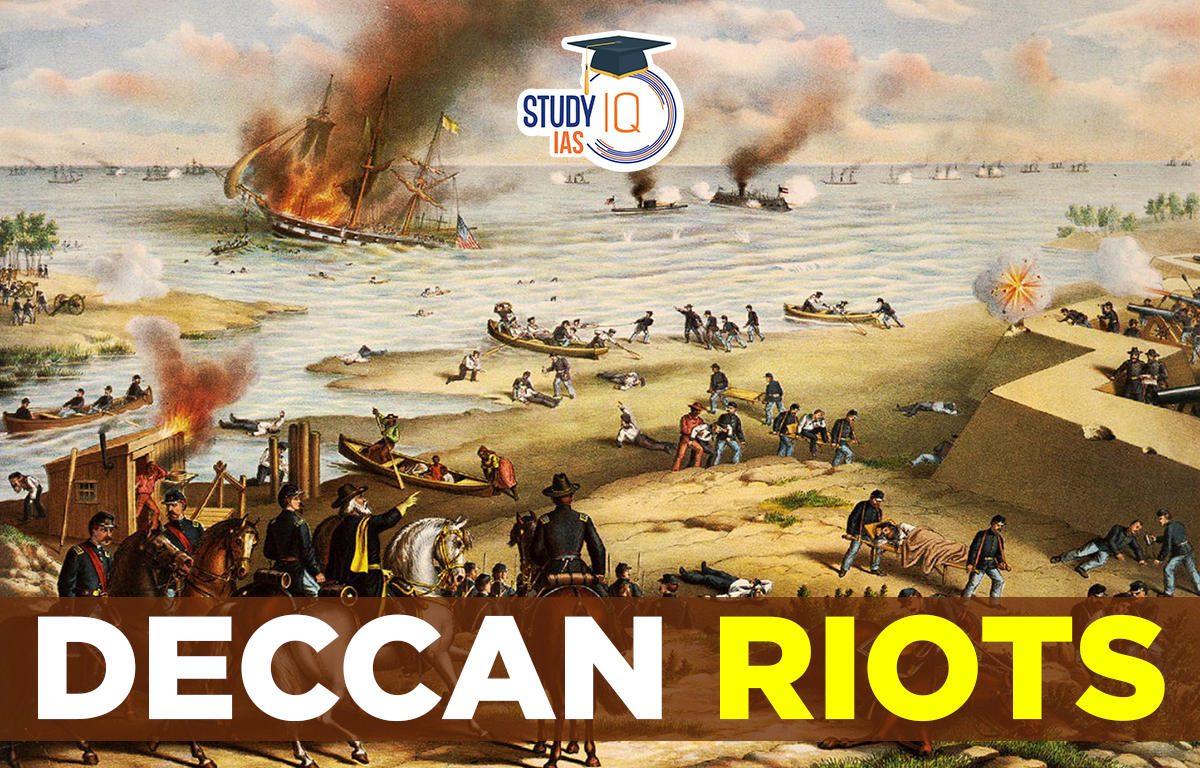Table of Contents
Deccan Riots
The Deccan Riots began in 1875 after the government increased land income by 50% in 1867, which worsened the conditions of peasants. In response to growing agrarian distress, peasants in Maharashtra started a rebellion in 1875. They started the uprising in protest against the high interest rates that lenders were charging them on their property and agricultural crops. They publicly shunned the lenders. This trend later spread to other regions of the nation. The Deccan Riots will be discussed in this article, which will be useful for UPSC exam preparation.
Read More: Poligars Revolt
Deccan Riots History
In the Bombay Deccan area, the British established the Ryotwari settlement as a land revenue system. Under this arrangement, the revenue from land was fixed annually. The agreement was made immediately between the government and the ryot in the Ryotwari System (cultivator). The revenue was based on the variety of soil and the farmer’s financial capacity. However, because of the high revenues, farms found it challenging to pay their taxes. Any halt to the rainfall would make the situation worse.
In order to pay their expenses, farmers usually borrow money from moneylenders. The producers learned after taking out the loans that the interest rates were unreasonably high, making repayment impossible. Debt among the peasants became a significant problem in rural regions. In 1861, a civil conflict broke out in the United States. The biggest source of cotton for British was the United States. Demand for cotton from India increased dramatically when the civil war started, which led to an increase in cotton cultivation there and a brief era of “boom” at the time.
But after the American conflict was over, cotton demand fell, which hurt farmers. Farmers were no longer eligible for loans from moneylenders, who had previously been generous with their debts during the Civil War. The farmers were furious because they were totally dependent on moneylenders and they showed no care for their situation.
Read More: Ramosi Uprising
Deccan Riots Causes
Peasants in Maharashtra, primarily in the districts of Poona, Satara, and Ahmednagar, rebelled in 1875 against the dishonest business practises of Gujarati and Marwari moneylenders. The moneylenders used to manipulate the accounts of the poor peasants and impose exorbitant interest rates. The ryots organized a social boycott campaign against moneylenders as a result.
They declined to labour in their homes and fields, or to purchase goods from their shops. Soon, agrarian unrest resulted from this societal boycott. The homes and businesses of the moneylender were repeatedly assaulted by the ryots. Moneylenders’ debt bonds, decrees, and other papers were seized and set openly on fire.
Read More: Bhil Revolt
Deccan Riots Commission
The Bombay administration was initially sceptical that the uprising was real when it spread throughout the Deccan. However, the 1857 events troubled the Indian administration, which applied pressure. The government of Bombay is establishing a committee to investigate the causes of the riots. A report produced by the commission was well welcomed. It was delivered to the British Parliament in 1878. This document, known as the Deccan Riots Report, provides historians with a variety of primary materials.
The disturbance was investigated. The commission investigated the matter based on information gathered from ryots, sahukars, and eyewitness accounts in the districts where the disturbances were most extensive. They also compiled reports from the district and statistics on revenue rates, pricing, and interest rates in various regions.
Read More: Khond Uprisings
Deccan Riots Outcome
The government established the Deccan Riot inquiry committee in 1877. According to the commission, the primary drivers of the uprising were destitution and debt. The Deccan Agriculturists Relief Act of 1879 was enacted by the government in 1897 in an effort to quell the movement and safeguard farmers from moneylenders. Vasudeo Balwant Phadke, an Indian nationalist, began a bloody uprising against colonial authority in 1879 with the goal of driving them out and establishing an Indian republic.
During the first fifty years of British control in western India, the Deccan Riots of 1875 illustrate the socioeconomic changes that took place in rural Maharashtra. Social historians are particularly interested in the riots because they focused on interactions between cultivators and moneylenders, two different rural social groups.
The focus of this investigation will be the social changes that gave rise to this controversy. I’ll also make an effort to link these changes to the societal ideals and political objectives that guided Maharashtra’s new rulers and influenced the state’s administrative strategy.
Read More: Santhal Rebellion
Deccan Riots UPSC
Falling agricultural prices, high taxes, and a feeling of governmental helplessness were the main causes of the cultivators’ distress. Under colonial land revenue policies, which prioritized access to credit to fund profitable investments in the land, small peasants were burdened by the commercialization of agriculture. Using capital provided by European merchants, local moneylenders acquired unrestricted title to their debtors’ assets and labour, giving them the “power to completely ruin and enslave the debtor.” For UPSC exams, this document contains all the necessary information about the Deccan Riots.
Read More: Munda Rebellion





















 WhatsApp
WhatsApp